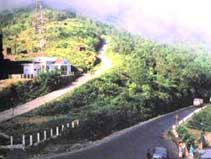The Hai Van Pass - Hai Van Gate

On a journey through the land, Hai Van is always an attractive landscape. Hai Van is highest pass in the country, full of perilous obstacles and is the last spur of the Truong Son Range reaching to the sea. In “Phu Bien Tap Luc”, Le Qui Don, the Viet Nam scholar who lived in the XVII century wrote that Hai Van with its foot standing in the sea surface and its summit covered with clouds. The pass standings as a borderline divide Thuan Hoa and Quang Nam provinces.
Hai Van means winds and clouds. Winds like a herd of horses galloping a number of miles, clouds like pouring from haven. Cao Ba Quat, the poet living in the XVII century only respected apricot blossom (Nhat sinh de thu bai mai hoa) was surprised when he was before the landscape: Nhat bich ngung vi gioi – Trung van nhieu tac thanh. On the summit of Hai Van pass, a panorama of the Danang city, Tien Sa port, Son Tra peninsular, Cu Lao Cham and a long white sandy beach can be seen.
Whatever endowed by nature, time by time and by hands of man will be something of humanitarian values. Coming to Hai Van is to come to the sanction of two land, to satisfy the peak-conquering philosophy, to mix ourselves in to echo of heroic songs of Vietnamese ancients when they went to find new lands to be emotional to prolong past of the Center region where suffering a lot of losses in the course of finding and protecting the nation.
